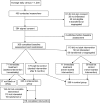Differential success rates in racial groups: results of a clinical trial of smoking cessation among female prisoners
- PMID: 19386816
- PMCID: PMC2688603
- DOI: 10.1093/ntr/ntp051
Differential success rates in racial groups: results of a clinical trial of smoking cessation among female prisoners
Abstract
Introduction: This study replicated prior observations of racial differences in smoking cessation in which Black smokers have demonstrated lower smoking cessation rates than White smokers.
Methods: The study used data from a smoking cessation intervention and compared White and Black female prisoners (N = 233) on a 10-week intervention of group psychotherapy and nicotine replacement (patch). Generalized estimating equations were used to model smoking cessation across the 12-month follow-up.
Results: Compared with an untreated control group, both Black and White smokers benefited from the cessation treatment. However, after controlling for potential confounds, White smokers had significantly higher overall smoking cessation rates across time compared with Black smokers (e.g., 30% vs. 24% abstinent at 6 weeks; 13% vs. 10% abstinent at 12 months). Smoking mentholated cigarettes was not associated with these differences in quit rates.
Discussion: Understanding differential treatment responses can lead to the development of more tailored and efficacious smoking cessation interventions that may reduce the morbidity and mortality associated with smoking in prison populations.
Figures



References
-
- Ahijevych K, Parsley LA. Smoke constituent exposure and stage of change in Black and White women cigarette smokers. Addictive Behaviors. 1999;24:115–120. - PubMed
-
- Ahijevych K, Weed H, Clark J. Levels of cigarette availability and exposure in Black and White women and efficient smokers. Pharmacology Biochemistry, and Behavior. 2004;77:685–693. - PubMed
-
- Belcher JM, Butler T, Richmond RL, Wodak AD, Wilhelm K. Smoking and its correlates in an Australian prisoner population. Drug and Alcohol Review. 2006;25:343–348. - PubMed
-
- Benowitz NL, Pomerleau OF, Pomerleau CS, Jacob P., III Nicotine metabolite ratio as a predictor of cigarette consumption. Nicotine & Tobacco Research. 2003;5:621–624. - PubMed
-
- Bureau of Justice Statistics. National Probation Data Survey, National Prisoner Statistics, Survey of Jails, and National Parole Data Survey. Correctional Populations in the United States. 1997 Retrieved April 9, 2009, from http://www.ojp.usdoj.gov/bjs/abstract/cpusst.htm.
Publication types
MeSH terms
Grants and funding
LinkOut - more resources
Full Text Sources
Medical

